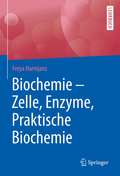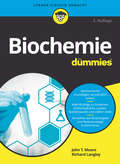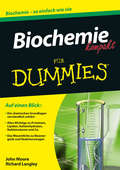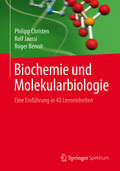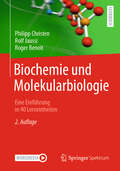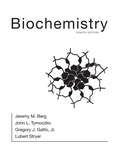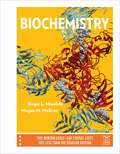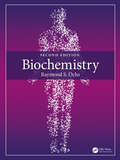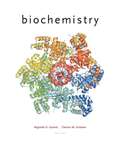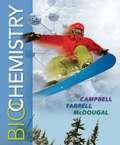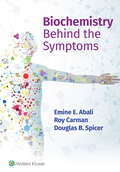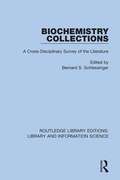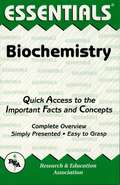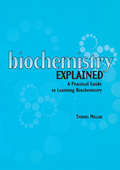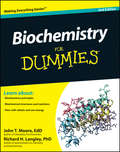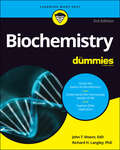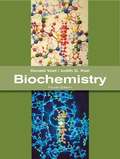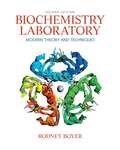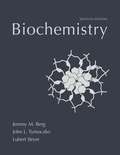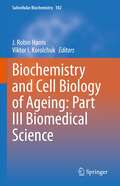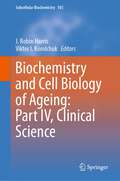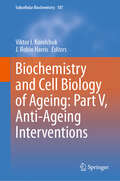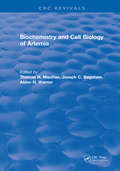- Table View
- List View
Biochemie - Zelle, Enzyme, Praktische Biochemie
by Freya HarmjanzWenn Sie die Biochemie im Großen und Ganzen verstehen wollen, ohne Unmengen von Details auswendig zu lernen, sind Sie hier richtig. In diesem Buch beginnt jedes Kapitel mit einer verständlichen Abbildung für den Überblick, bevor es in die Tiefe geht. So laufen Sie nicht Gefahr, den Überblick zu verlieren. Bei der Erklärung der vielen Moleküle werden die Zusammenhänge innerhalt der Biochemie dargestellt und dabei die drei wichtigen Fragen beantwortet: · Woher kommt das Molekül?· Was macht es hier?· Wo geht es danach hin? Und für die Klinik gibt es Antwort auf die spannende Frage: · Was passiert eigentlich, wenn hier was schief geht? Da die Semesterklausuren häufig schwieriger sind als das Examen, legt das Buch seinen Schwerpunkt auf die Klausuren. So sind Sie für alle Fälle gut gerüstet. Und damit die Biochemie handlich bleibt, ist der Stoff auf drei Bände verteilt: Band 1 Zelle, Enzyme und praktische Biochemie Band 2 Energiestoffwechsel Band 3 Regulation, Blut, Krankheitserreger
Biochemie für Dummies (Für Dummies)
by John T. Moore Richard H. LangleyHaben Sie Ihre liebe Mühe mit der Biochemie? Diese ganzen Formeln und Reaktionen sind überhaupt nicht Ihr Ding? Die nächste Prüfung steht vor der Tür? Kein Problem! In diesem Buch erklärt der Autor Ihnen, was Sie über Biochemie wissen müssen. Er führt Sie so einfach wie möglich und so komplex wie nötig in die Welt der Kohlenhydrate, Lipide, Proteine, Nukleinsäuren, Vitamine, Hormone und Co. ein. So leicht kann Biochemie sein.
Biochemie für Mediziner für Dummies (Für Dummies)
by Gerhard PüschelIhr Wegweiser durch den Dschungel der Biochemie Sie müssen eine Biochemie-Prüfung bestehen und Biochemie erscheint Ihnen so unanschaulich und schwer verständlich, das absolute Horrorfach? In diesem Buch werden biochemische Grundlagen und Zusammenhänge leicht verständlich erklärt. Über 300 speziell für dieses Buch entworfene Abbildungen und Schemata machen den Stoff anschaulicher und helfen Ihnen, den Durchblick zu bekommen. Gerhard Püschel erklärt Ihnen Stoffwechselwege und deren Regulation, Kommunikation zwischen Zellen und Organen, Zellzykluskontrolle und vieles mehr auf wissenschaftlich aktuellem Stand, aber »gut verdaulich«, damit das Lernen auch ein wenig Spaß macht. Sie erfahren Was Sie über Kohlenhydrat-, Lipid- und Proteinstoffwechsel wissen sollten Welche Funktion Vitamine und Spurenelemente haben Wie Replikation, Transkription, Translation und Kontrolle der Genexpression funktionieren Wie Hormone, Cytokine und deren Rezeptoren Zell- und Organfunktion steuern
Biochemie kompakt für Dummies (Für Dummies)
by John T. Moore Richard H. LangleyDer schnelle Überblick für Schüler, Studenten und jeden, den es sonst noch interessiert Stehen Sie auf Kriegsfuß mit der Biochemie? Diese ganzen Formeln und Reaktionen sind überhaupt nicht Ihr Ding, aber die nächste Prüfung steht vor der Tür? Kein Problem! Biochemie kompakt für Dummies erklärt Ihnen das Wichtigste, was Sie über Biochemie wissen müssen. Sie warden so einfach wie möglich und so komplex wie nötig in die Welt der Kohlenhydrate, Lipide, Proteine, Nukleinsäuren, Vitamine, Hormone und Co. eingeführt. So leicht und kompakt kann Biochemie sein.
Biochemie kompakt für Dummies (Für Dummies)
by John T. Moore Richard H. LangleyStehen Sie auf Kriegsfuß mit der Biochemie? Diese ganzen Formeln und Reaktionen sind überhaupt nicht Ihr Ding? Die nächste Prüfung steht vor der Tür? Kein Problem! "Biochemie kompakt für Dummies" erklärt Ihnen das Wichtigste, was Sie über Biochemie wissen müssen. Sie werden so einfach wie möglich und so komplex wie nötig in die Welt der Kohlenhydrate, Lipide, Proteine, Nukleinsäuren, Vitamine, Hormone und Co. eingeführt. So leicht und kompakt kann Biochemie sein.
Biochemie und Molekularbiologie: Eine Einführung in 40 Lerneinheiten
by Philipp Christen Rolf Jaussi Roger BenoitDiese Einf#65533;hrung in die Biochemie und Molekularbiologie ist f#65533;r alle geschrieben, die sich f#65533;r die molekularen Aspekte der Lebensvorg#65533;nge interessieren, insbesondere f#65533;r Studierende der Medizin und der Naturwissenschaften, denen die Biochemie als Grundlagenwissenschaft dient. Die 40 kurzen Kapitel k#65533;nnen weitgehend unabh#65533;ngig voneinander benutzt werden. Mit seinem hohen Bildanteil setzt das Buch auf visuelles Lernen. Zu jedem Kapitel gibt es eine ausf#65533;hrliche, kommentierte Linksammlung, die u. a. Bildmaterial, Animationen, Datenbanken sowie Merks#65533;tze und Kontrollfragen enth#65533;lt. Die Inhalte der Website k#65533;nnen #65533;ber QR-Codes im Buch, aber auch #65533;ber die Webadresse abgerufen werden. Das Lehrbuch basiert auf dem 2005 von den Autoren ver#65533;ffentlichten Titel Biochemie. Der Text ist korrigiert, erg#65533;nzt und gestrafft worden.
Biochemie und Molekularbiologie: Eine Einführung in 40 Lerneinheiten
by Philipp Christen Rolf Jaussi Roger BenoitDiese Einführung in die Biochemie und Molekularbiologie ist für alle geschrieben, die sich für die molekularen Aspekte der Lebensvorgänge interessieren, insbesondere für Studierende der Medizin und der Naturwissenschaften, denen die Biochemie als Grundlagenwissenschaft dient. Die 40 kurzen Kapitel können weitgehend unabhängig voneinander benutzt werden. Mit seinem hohen Bildanteil setzt das Buch auf visuelles Lernen. Über eine das Buch ergänzende Website erhalten Sie Zugang zur ausführlichen, kommentierten Linksammlung, die u.a. Bildmaterial, Animationen, Datenbanken sowie Merksätze und Kontrollfragen für jedes einzelne Kapitel enthält. Für die Neuauflage haben die Autoren den Text überarbeitet und aktualisiert; im Methodenteil ist die Beschreibung der bildgebenden Verfahren ausgebaut worden.
Biochemistry
by Jr. John L. Tymoczko Jeremy M. Berg Lubert Stryer Gregory J. GattoFor four decades, this extraordinary textbook played an pivotal role in the way biochemistry is taught, offering exceptionally clear writing, innovative graphics, coverage of the latest research techniques and advances, and a signature emphasis on physiological and medical relevance. Those defining features are at the heart of this edition. See what's in the LaunchPad
Biochemistry
by Roger L. Miesfeld Megan M. McEvoyBiochemistry promotes understanding of biochemical concepts through highly readable chapters that consistently integrate stunning graphics with text. Its distinctive table of contents highlights how biochemical processes work, and applications to everyday biochemistry ensure that students develop a complete understanding of why biochemistry matters.
Biochemistry
by Raymond S. OchsBiochemistry Second Edition, is a single-semester text designed for undergraduate non-biochemistry majors. Accessible, engaging, and informative, it is the perfect introduction to the subject for students who may approach chemistry with apprehension. Its unique emphasis on metabolism and its kinetic underpinnings gives the text up-to-the-minute relevance for students investigating current public health concerns, such as obesity and diabetes. Biochemistry Second Edition will encourage students to explore the basics of chemistry and its influence on biological problems. Key Features: Provides an understanding of (mostly) enzymatic reactions that are responsible for the function and maintenance of living things. This innovative text for non-biochemistry majors includes introductory material at the beginning of each chapter that contextualizes chapter themes in real-life scenarios. Online supporting materials with further opportunities for research and investigation. Synthesis questions at the end of each chapter that encourage students to make connections between concepts and ideas, as well as develop critical-thinking skills. About the Author: Raymond S. Ochs is a biochemist with a career-long specialty in metabolism spanning 30 years. Previously, he has written the textbook Biochemistry, contributed the metabolism chapters to another text, Principles of Biochemistry, and co-edited a collection of articles published as Metabolic Regulation, and the recent monograph Metabolic Strucure and Regulation. His research interests concern major pathways of liver and muscle, including glycolysis, gluconeogenesis, ureogenesis, fatty acid metabolism, glycogen metabolism, and control by cAMP, Ca2+, diacylglycerol, and AMPK. He is currently professor of pharmacy at St. John’s University in New York, teaching biochemistry, physiology, and medicinal chemistry.
Biochemistry (6th Edition)
by Reginald H. Garrett Charles M. GrishamContinuing Garrett and Grisham's innovative conceptual and organizing Essential Questions framework, BIOCHEMISTRY guides students through course concepts in a way that reveals the beauty and usefulness of biochemistry in the everyday world. Offering a balanced and streamlined presentation, this edition has been updated throughout with new material and revised presentations. For the first time, this book is integrated with OWL, a powerful online learning system for chemistry with book-specific end-of-chapter material that engages students and improves learning outcomes.
Biochemistry (Ninth Edition)
by Mary Campbell Shawn Farrell Owen M. McDougalIdeal for those studying biochemistry for the first time, this proven book balances scientific detail with readability and shows you how principles of biochemistry affect your everyday life. Designed throughout to help you succeed (and excel!), the book includes in-text questions that help you master key concepts, end-of-chapter problem sets grouped by problem type that help you prepare for exams, and state-of-the art visuals that help you understand key processes and concepts. In addition, visually dynamic Hot Topics cover the latest advances in the field, while Biochemical Connections demonstrate how biochemistry affects other fields, such as health and sports medicine.
Biochemistry Behind the Symptoms
by Emine E. Abali Roy Carman Douglas SpicerBiochemistry Behind the Symptoms takes a problem-based approach to understanding and applying biochemistry for superior clinical outcomes. Organized around the common symptoms encountered by clinicians, this engaging text clarifies the connections between foundational science and clinical manifestations to help users form confident diagnoses throughout their clerkship and beyond. Each chapter explores the biochemical concepts behind underlying causes and demonstrates their ties to presenting symptoms through 5 realistic patient cases. Accompanying questions encourage discussion and guide users in building accurate differential diagnoses. Ideal for peer-to-peer learning environments or independent study, this practical approach strengthens users’ application of fundamental knowledge and ensures the long-term retention essential to clinical success.
Biochemistry Collections: A Cross-Disciplinary Survey of the Literature (Routledge Library Editions: Library and Information Science #10)
by Bernard S. SchlessingerThis book, first published in 1982, offers an examination of the special nature of biochemistry collections. It focuses on the production, control, and use of the literature – diverse in nature, and analysed here by specialist contributors.
Biochemistry Essentials
by Jay TemplinREA's Essentials provide quick and easy access to critical information in a variety of different fields, ranging from the most basic to the most advanced. As its name implies, these concise, comprehensive study guides summarize the essentials of the field covered. Essentials are helpful when preparing for exams, doing homework and will remain a lasting reference source for students, teachers, and professionals. Biochemistry includes biological structure, chemistry of proteins, enzymes, bioenergetics, carbohydrates, lipids, metabolism of amino acids and proteins, nucleic acids, and extra cellular and intracellular fluids.
Biochemistry Explained: A Practical Guide to Learning Biochemistry
by Thomas MillarBiochemistry Explained employs an innovative approach which has proven highly successful in the author's own classes. The author establishes a thorough understanding of the foundations of and common linkages between molecular structures and reactions, so that eventual interpretation of complex biochemical pathways and reactions is easy. All of the major molecular structures and biochemical pathways are explained, and, for the most part, these center on mammalian biochemistry. The text is supported by biochemical nomenclature and questions to bear in mind while reading. Higher learning sections are also provided for advanced students. Written in an informal, conversational style, this textbook will serve as an invaluable resource for any student who is struggling with the standard texts and for postgraduate students who need to refresh their knowledge.
Biochemistry For Dummies
by John T. Moore Richard H. LangleyGrasp biochemistry basics, apply the science, and ace your examsAre you baffled by biochemistry? If so here's the good news ? you don't have to stay that way! Biochemistry For Dummies shows you how to get a handle on biochemistry, apply the science, raise your grades, and prepare yourself to ace any standardized test.This friendly, unintimidating guide presents an overview of the material covered in a typical college-level biochemistry course and makes the subject easy to understand and accessible to everyone. From cell ultrastructure and carbohydrates to amino acids, proteins, and supramolecular structure, you'll identify biochemical structures and reactions, and send your grades soaring. Newest biology, biochemistry, chemistry, and scientific discoveriesUpdated examples and explanationsIncorporates the most current teaching techniquesFrom water biochemistry to protein synthesis, Biochemistry For Dummies gives you the vital information, clear explanations, and important insights you need to increase your understanding and improve your performance on any biochemistry test.
Biochemistry For Dummies
by John T. Moore Richard H. LangleyIt’s alive! It’s alive! (Thanks to biochemistry, that is.) Biochemistry is the science of the chemical processes that allow for…well…life. If it moves, breathes, eats, or sleeps, biochemistry can probably explain how. So, it stands to reason that the fundamentals of biochemistry can get a little complicated. In Biochemistry For Dummies, you’ll explore the carbons, proteins, and cellular systems that make up the biochemical processes that create and sustain life of all kinds. Perfect for students majoring in biology, chemistry, pre-med, health-services, and other science-related fields, this book tracks a typical college-level biochemistry class. It simplifies and clarifies the subject with easy-to-follow diagrams and real-world examples. You’ll also get: Explorations of cell biology, carbohydrates, proteins, lipids, and other fundamental building blocks of life Discussions of the basic structures common to all living organisms Treatments of the microscopic details of life that make us all tick If you’re looking for a hand with some of the trickier parts of biochemistry—or you just need an accessible overview of the subject—check out Biochemistry For Dummies today!
Biochemistry Fourth Edition
by Donald Voet Judith G. VoetThe "Gold Standard" in Biochemistry text books, Biochemistry 4e, is a modern classic that has been thoroughly revised. Don and Judy Voet explain biochemical concepts while offering a unified presentation of life and its variation through evolution. Incorporates both classical and current research to illustrate the historical source of much of our biochemical knowledge.
Biochemistry Laboratory: Modern Theory and Techniques
by Rodney BoyerYour biochemistry lab course is an essential component in training for a career in biochemistry, molecular biology, chemistry, and related molecular life sciences such as cell biology, neurosciences, and genetics. <p><p>Biochemistry Laboratory: Modern Theory and Techniques covers the theories, techniques, and methodologies practiced in the biochemistry teaching and research lab. Instead of specific experiments, it focuses on detailed descriptions of modern techniques in experimental biochemistry and discusses the theory behind such techniques in detail. An extensive range of techniques discussed includes Internet databases, chromatography, spectroscopy, and recombinant DNA techniques such as molecular cloning and PCR. <p><p>The Second Edition introduces cutting-edge topics such as membrane-based chromatography, adds new exercises and problems throughout, and offers a completely updated Companion Website.
Biochemistry Seventh Edition
by John L. Tymoczko Jeremy M. Berg Lubert StryerSince its first edition in 1975, this extraordinary textbook has helped shape the way biochemistry is taught, offering exceptionally clear writing, innovative graphics, coverage of the latest research techniques and advances, and a signature emphasis on physiological and medical relevance. Those defining features are at the heart of the new Seventh Edition of Biochemistry, which again communicates fundamental concepts and the latest breakthroughs in a way that makes the information engaging and understandable for students approaching the subject for the first time.
Biochemistry and Cell Biology of Ageing: Part III Biomedical Science (Subcellular Biochemistry #102)
by J. Robin Harris Viktor I. KorolchukThis book provides a state-of-the-art overview of key areas of subcellular aging research in human cells. The reader is introduced to the historical development and progress in biomedical aging research and learns, for example, about the role of microRNAs, circRNAs, mitochondria and extracellular vesicles in cellular senescence. The reader will also learn more about how gap junctions, the nuclear pore complex and the proteasome are affecting the ageing processes. In addition, novel therapeutic opportunities through modulation of cellular senescence are discussed. The book follows on from Parts I and II of Biochemistry and Cell Biology of Ageing (Volumes 90 and 91 of the Subcellular Biochemistry book series) by covering interesting and significant biomedical ageing topics not included in the earlier volumes. Comprehensive and cutting-edge, this book is a valuable resource for experienced researchers and early career scientist alike, who are interested in learning more about the fascinating and challenging question of why and how our cells age.
Biochemistry and Cell Biology of Ageing: Part IV, Clinical Science (Subcellular Biochemistry #103)
by J. Robin Harris Viktor I. KorolchukThis book provides an up-to-date overview of key areas of ageing research and bridges the gap between the subcellular events and the reality of ageing as seen in clinical practice.To this end, the reader learns about the historical development and progression of clinical ageing research. All chapters address the biochemistry or cell biology of various ageing events (to the extent that the data are available) and work their way to the clinical understanding we have of ageing. The focus of this volume is on how dietary restriction, virus infection and chronic inflammation affect the ageing process. Additionally, this book discusses how phosphate metabolism and metabolic dysfunction contribute to ageing events and how various organs and tissues (e.g. tendons, ears, heart muscle, and the endocrine system) age. This book follows on from Parts I, II and III of Biochemistry and Cell Biology of Ageing within the Subcellular Biochemistry book series and aims to bring the subcellular and clinical areas into closer contact by including interesting and significant biomedical ageing topics that were not included in the earlier volumes. Comprehensive and cutting-edge, this book is a valuable resource for experienced researchers and early career scientist alike, who are interested in learning more about the fascinating and challenging question of why and how our cells age.
Biochemistry and Cell Biology of Ageing: Part V, Anti-Ageing Interventions (Subcellular Biochemistry #107)
by J. Robin Harris Viktor I. KorolchukThis book provides an up-to-date overview of key areas of ageing research with a special focus on anti-ageing intervention strategies, which are currently very much at the forefront of ageing studies.The volume discusses how dietary restriction, supplements or exercise affect the ageing process. Other intervention strategies reviewed are: chaperone activators, telomerase activation, hormetics, senolytics, NAD boosting, geroprotectors, stem cell therapies, resveratrol and melatonin, to just name a few. This book follows on from Parts I-IV of Biochemistry and Cell Biology of Ageing within the Subcellular Biochemistry book series and highlights anti-ageing intervention strategies that were not included in the earlier volumes. Comprehensive and cutting-edge, this book is a valuable resource for experienced researchers and early career scientists alike, who are interested in learning more about the fascinating and challenging question of why and how our cells age.
Biochemistry and Cell Biology of Artemia
by Thomas H. MacRaeThe unusual life history of the brine shrimp, Artemia, and the relative ease with which it can be experimentally manipulated have long made his crustacean a favorite system for biological studies. Over the years, descriptive morphological work has given way to a rigorous analysis of biochemical and cellular aspects of the organism. The underlying theme of the work is often been developmental in nature.This book brings together a wide spectrum of topics under study in the shrimp. Analyses of gene structure and protein synthesis are combined with descriptions of protein interactions characteristic of functional cells.
